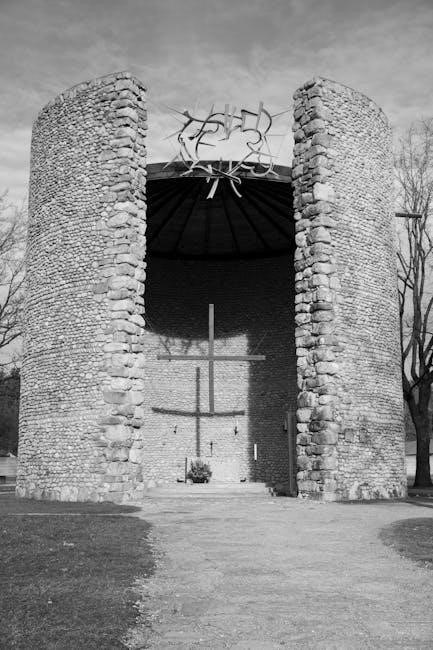
The W&OD Trail Map PDF is a comprehensive guide to the 45-mile Washington and Old Dominion Trail, offering detailed routes, mile markers, and essential amenities for planners.
Overview of the W&OD Trail
The Washington and Old Dominion (W&OD) Trail is a 45-mile paved rail-trail stretching from Arlington to Purcellville, Virginia. Managed by NOVA Parks, it offers a scenic route for cycling, jogging, and horseback riding. The trail follows the former W&OD Railroad corridor, providing a flat, accessible path through urban and rural landscapes. It features mile markers, rest areas, and connections to parks, restaurants, and historic sites. The W&OD Trail is a popular destination for outdoor enthusiasts, blending history, nature, and recreation.
Importance of the Trail Map
The W&OD Trail Map PDF is invaluable for planning and navigating the 45-mile route. It provides detailed mile markers, access points, and amenities, ensuring users can explore confidently. The map highlights parking areas, restrooms, water stations, and scenic spots, making it essential for cyclists, joggers, and walkers. It also assists in identifying nearby landmarks and connecting trails, enhancing the overall experience. Downloading the map for offline use ensures accessibility in areas with limited network coverage, making it a must-have resource for all trail users.

Key Features of the W&OD Trail Map PDF
The W&OD Trail Map PDF features an interactive map, downloadable for offline use, with detailed mileage markers and points of interest to aid exploration and planning.
Interactive Map of the Washington and Old Dominion Trail
The W&OD Trail’s interactive map provides a detailed visual guide, highlighting the 45-mile route from Shirlington to Purcellville. It includes mile markers, parking spots, rest areas, and points of interest, ensuring users can navigate seamlessly. The map is accessible online and via apps like HiiKER, allowing offline use in areas with limited connectivity. This feature-rich tool helps cyclists, walkers, and nature enthusiasts plan their journeys efficiently, explore scenic spots, and stay informed about trail conditions and amenities along the way. It’s an indispensable resource for both first-time visitors and regular trail users.
Downloading the W&OD Trail Map for Offline Use
The W&OD Trail Map PDF can be downloaded for offline use, ensuring navigation remains possible in areas with limited or no internet connectivity. Users can access the map through platforms like the HiiKER app, which offers free downloads. The offline version includes detailed trail markers, parking locations, rest areas, and points of interest. This feature is particularly useful for cyclists, hikers, and outdoor enthusiasts exploring remote sections of the 45-mile trail. Downloading the map in advance ensures uninterrupted access to critical information during your journey.
Understanding the Trail’s Mileage and Markers
The W&OD Trail spans 45 miles, with mile markers every 0.5 miles, providing clear guidance for users. The trail features a nine-foot-wide asphalt surface with a painted yellow center line, ensuring safe navigation. Markers include interpretive signs that highlight historical sites, landmarks, and trail amenities, enriching the user experience. These markers help cyclists, joggers, and walkers track their progress and plan their route effectively, making the trail user-friendly and accessible for all levels of outdoor enthusiasts.

Trail Details and Amenities
The W&OD Trail is a 45-mile paved path offering restrooms, water stations, picnic areas, and ample parking. It connects to regional parks and features scenic countryside views.
Trail Length and Surface Type
The W&OD Trail spans 45 miles, offering a relatively flat journey on a paved asphalt surface. The trail features a nine-foot-wide path with a painted yellow center line, ensuring clear navigation. A parallel crushed-stone trail, popular with equestrians and mountain bikers, accompanies the paved route for 32 miles. These surfaces cater to various activities, making the trail accessible for cyclists, joggers, and walkers alike. The consistent paving and markings enhance safety and convenience for all users along the route.
Parking Options and Access Points
The W&OD Trail offers numerous parking options along its 45-mile stretch, with access points in Arlington, Fairfax, and Loudoun Counties. Key parking areas include Shirlington, Bluemont Park, Herndon, Reston, and Purcellville. These locations provide convenient access to the trail, with amenities like restrooms and water stations available at many stops. Additional parking lots are strategically placed near major intersections and landmarks, ensuring easy entry and exit points for users to explore different sections of the trail efficiently.
Restrooms, Water Stations, and Picnic Areas
Restrooms and water stations are conveniently located at key points along the W&OD Trail, including Bluemont Park, Herndon, and Purcellville. Picnic areas are also available, offering scenic spots to relax and enjoy the surroundings. These amenities are well-marked on the trail map, ensuring users can plan their stops efficiently. Water availability may vary seasonally, so checking the map for confirmed stations is recommended. These facilities enhance the overall trail experience, catering to both casual visitors and long-distance travelers.

Planning Your Journey
The W&OD Trail Map PDF is essential for planning, offering interactive features to explore routes, landmarks, and connections, ensuring a well-organized and enjoyable trip along the trail.
How to Use the Map for Route Planning
The W&OD Trail Map PDF is an invaluable tool for planning your journey. It provides detailed mile markers, access points, and landmarks, helping you navigate the 45-mile trail seamlessly. Use the interactive map to identify parking areas, restrooms, and scenic spots. Download the map offline via the HiiKER app to ensure navigation in low-network areas. The PDF also includes a suite of maps by Dmitriy Tarasov, offering elevation measurements and key landmarks for precise route planning. This resource ensures a well-organized and enjoyable trip.
Identifying Landmarks and Points of Interest
The W&OD Trail Map PDF highlights key landmarks and points of interest along the 45-mile route. Historic sites like the Purcellville Train Depot and old cabooses in Herndon and Vienna are marked. Natural attractions, such as Bluemont Park and scenic farmland, are also noted. The map includes mile markers and access points, helping users locate rest areas, water stations, and picnic spots. Use the map to explore photogenic spots, such as fall foliage areas, and plan stops at charming towns like Leesburg for dining and antiquing.
Connecting to Other Trails and Parks
The W&OD Trail Map PDF provides connections to other regional trails and parks, enhancing your exploration. It links to the Capital Crescent Trail via the East Falls Church Station and the Meadowlark Connector Trail near Reston. Additionally, it connects to the Bluemont Junction Trail, offering extended routes through scenic areas. The map also highlights access points to local parks, such as Bluemont Park, and future expansion plans to integrate with more trails, making it a hub for diverse outdoor adventures in Northern Virginia.

Trail History and Maintenance
The W&OD Trail, built in 1859, was converted into a rail-trail starting in 1974 and completed in 1988 by NOVA Parks with volunteer support for ongoing upkeep.
Historical Background of the W&OD Railroad
The Washington and Old Dominion Railroad was constructed in 1859, shortly before the Civil War, and operated until its decline in 1968. Originally built to connect the Shenandoah Valley with Alexandria, it played a crucial role in transporting goods and passengers. After its closure, the rail line was repurposed into a trail, with the first sections opening in 1974 under an agreement with Virginia Electric and Power Company. The full 45-mile trail was completed in 1988, managed by NOVA Parks and supported by volunteers from the Friends of the W&OD.
Conversion to a Rail-Trail and Current Maintenance
The Washington and Old Dominion Railroad was transformed into a rail-trail, with initial sections opening in 1974 and completed by 1988. Managed by NOVA Parks, the trail is maintained with volunteer support from Friends of the W&OD. It features a paved path for cyclists and a parallel crushed-stone path for equestrians and hikers. Regular upkeep ensures the trail remains well-maintained, with mile markers and interpretive signs providing historical context. The trail is part of the Capital Trails Coalition, connecting it to other regional trails.
Role of NOVA Parks and Volunteers
NOVA Parks manages the W&OD Trail, ensuring its maintenance and preservation. Volunteers from the Friends of the W&OD contribute significantly to repairs, cleanups, and trail enhancements. Their efforts include organizing events, maintaining facilities, and advocating for trail improvements. This collaboration ensures the trail remains accessible and enjoyable for all users, fostering a strong sense of community ownership and environmental stewardship.

Safety and Etiquette
Exercise caution at road crossings, especially during rush hour, and stay alert for cyclists and other users. Always follow trail rules and respect shared spaces.
Safety Tips for Trail Users
Always stay alert and aware of your surroundings while on the W&OD Trail. Keep to the right and be mindful of cyclists, joggers, and horseback riders. Avoid wearing headphones at high volume to maintain situational awareness. Wear reflective or brightly colored clothing for visibility. Carry water and snacks, especially on longer trips, and inform someone of your route and expected return time. Cyclists should signal when passing and ride at safe speeds. Be prepared for road crossings and follow all posted safety guidelines.
Rules and Regulations for Trail Usage
Adhere to posted rules and regulations on the W&OD Trail to ensure a safe and enjoyable experience for all users. The trail is open daily from dawn to dusk, and all users must yield to horses. Cyclists must ride at moderate speeds and use bells to alert others. Dogs must be leashed, and waste should be properly disposed of. No motorized vehicles are permitted except for authorized maintenance. Respect private property and trail signs, and avoid littering to preserve the environment and maintain the trail’s natural beauty for future visitors.
Environmental Considerations
Preserving the natural beauty of the W&OD Trail is crucial for its ecosystem and user experience. Avoid littering and stay on designated paths to protect habitats. Dominion Energy’s tree removal along the trail has sparked concerns about environmental impact. Users are encouraged to respect wildlife and vegetation, ensuring the trail remains a sustainable resource for future generations. NOVA Parks and volunteers work tirelessly to maintain balance between trail accessibility and environmental conservation, promoting eco-friendly practices for all visitors.

Popular Activities on the W&OD Trail
The W&OD Trail is a hub for cycling, jogging, walking, and photography, attracting outdoor enthusiasts who enjoy its scenic beauty and diverse recreational opportunities year-round.
Cycling, Jogging, and Walking
The W&OD Trail is a popular destination for cycling, jogging, and walking, offering a 45-mile paved path with a yellow center line. Cyclists appreciate its relatively flat terrain, while joggers and walkers enjoy the scenic views. The trail’s wide surface accommodates various paces, from leisurely strolls to intense workouts. Many users highlight the trail’s suitability for building speed, with fitness enthusiasts often spotted, especially during early mornings. The route’s diverse landscapes, from urban areas to rural countryside, make it a favorite for outdoor enthusiasts seeking both exercise and nature.
Horseback Riding and Equestrian Access
The W&OD Trail provides a dedicated gravel path for horseback riding and equestrian activities, separate from the paved section. This 32-mile trail is ideal for equestrians, offering a natural, less crowded experience. Horses are restricted to this area, ensuring safety for all users. The trail winds through scenic countryside, including rolling hills and woodlands, making it a picturesque route for riders. Equestrians can access the trail at designated points, with parking areas accommodating horse trailers. The trail’s maintenance and clear signage make it a haven for horseback riding enthusiasts.
Photography and Nature Observation
The W&OD Trail is a paradise for photographers and nature enthusiasts, offering diverse landscapes from urban backdrops to rural countryside. Seasonal changes, particularly the vibrant fall foliage, provide stunning visuals. Wildlife, including deer and birds, can often be spotted along the trail. The mix of open fields, woodlands, and historic structures creates a rich tapestry for capturing memorable shots. Visitors are encouraged to bring cameras to document the trail’s natural beauty and unique charm, making it a perfect destination for photography and nature observation year-round.

Seasonal and Special Events
The W&OD Trail hosts various seasonal events, including fall foliage festivals, spring bike rides, and winter walks. Community involvement and group activities enhance the trail’s vibrant atmosphere.
Annual Events and Festivals
The W&OD Trail is vibrant with annual events, including fall foliage festivals in Purcellville, spring bike rides, and seasonal community gatherings. The trail’s eastern endpoint hosts cultural celebrations, while the western section features rural fairs. Annual marathons and charity rides attract fitness enthusiasts, while family-friendly events like Halloween walks and holiday markets add charm. These events, highlighted on the trail map, offer something for everyone, fostering a sense of community and connection along the 45-mile corridor.
Seasonal Activities and Scenic Views
The W&OD Trail offers breathtaking scenery year-round, with vibrant fall foliage, spring wildflowers, and serene winter landscapes. Cyclists and hikers enjoy the trail’s rolling hills and farmland views, while photographers capture stunning vistas. Seasonal activities include apple picking in fall, summer picnics, and winter birdwatching. The trail map PDF highlights scenic stops like Bluemont Park and historic landmarks, making it easy to plan visits during peak beauty. Each season brings unique charm, from blooming flowers to golden harvests.
Community Involvement and Group Rides
The W&OD Trail fosters strong community ties through group rides and events. Local cycling clubs and running groups organize regular meetups, while NOVA Parks and volunteers host cleanups and educational programs. The trail map PDF highlights popular gathering spots and event locations, encouraging social connections. Seasonal festivals and charity rides further strengthen community bonds, making the W&OD a hub for shared outdoor experiences and camaraderie among trail enthusiasts.

Trail Connections and Extensions
The W&OD Trail seamlessly connects to the Capital Crescent Trail and other regional trails, expanding route options. Future plans aim to enhance these connections, improving accessibility and exploration.
Connecting to the Capital Crescent Trail
The W&OD Trail connects seamlessly to the Capital Crescent Trail near the East Falls Church Metro Station, offering a continuous route for cyclists and hikers. This connection provides access to the Potomac River and Georgetown, expanding the trail network. Both trails are popular for their scenic views and historical significance, making them a favorite for outdoor enthusiasts. The W&OD Trail’s paved surface and the Capital Crescent Trail’s mix of surfaces cater to various user preferences, enhancing the overall trail experience in Northern Virginia.
- Seamless connection at East Falls Church
- Access to Potomac River and Georgetown
- Scenic and historical routes combined
- Catery to cyclists, hikers, and nature lovers
Links to Other Regional Trails
The W&OD Trail seamlessly connects to other regional trails, expanding outdoor exploration opportunities. It links to the Meadowlark Connector Trail between Vienna and Reston, offering a mile-long route for cyclists and hikers. Additionally, the Bluemont Junction Trail provides further connections, enhancing access to scenic routes and parks. These links create a network of trails, allowing users to explore diverse landscapes, from urban areas to rural countryside, while enjoying activities like biking, walking, and nature observation.
- Meadowlark Connector Trail
- Bluemont Junction Trail
- Scenic routes and park access
- Diverse landscapes for exploration
Future Expansion Plans
Future plans for the W&OD Trail include potential extensions and improvements to enhance connectivity and accessibility. Efforts are underway to explore links to neighboring trails and expand the network for broader regional access. NOVA Parks is actively involved in planning and community engagement to ensure sustainable growth. These initiatives aim to preserve the trail’s natural beauty while accommodating increasing user demand, ensuring the W&OD remains a premier destination for outdoor enthusiasts.
- Exploring trail extensions
- Enhancing regional connectivity
- Sustainable growth initiatives

User Reviews and Testimonials
Users praise the W&OD Trail for its scenic beauty, well-maintained paths, and versatility for cycling, jogging, and walking. Many highlight its family-friendly atmosphere and convenient amenities.
Visitor Experiences and Feedback
Visitors rave about the W&OD Trail’s scenic beauty, with many highlighting its well-maintained paths and family-friendly atmosphere. Cyclists and joggers appreciate its versatility, while walkers enjoy the serene landscapes. The trail’s fall foliage is a particular favorite, with vibrant colors attracting photographers. Users often praise the convenient access to amenities like restrooms, water stations, and picnic areas. Some mention the trail’s historical charm, with landmarks and interpretive signs adding educational value. Overall, the W&OD Trail is celebrated for its accessibility and connection to nature, making it a beloved destination for outdoor enthusiasts of all ages.
Recommendations for First-Time Users
First-time users should start at less crowded sections, such as west of Leesburg, to enjoy a peaceful experience. Bring water, snacks, and a downloaded map for offline use. Plan your route using the W&OD Trail Map PDF to identify access points, parking, and amenities. Wear appropriate gear and stay alert, especially near urban areas. Respect trail etiquette by staying to the right and yielding to others. Take time to enjoy scenic views, historical landmarks, and seasonal foliage, making your journey memorable and enjoyable.
Favorite Sections and Hidden Gems
The W&OD Trail’s western section, near Purcellville, is a favorite for its scenic rural landscapes and access to charming barbecue spots. Hidden gems include the rolling hills, picturesque farmland, and vibrant fall foliage. Bluemont Park, with its historic caboose and picnic areas, is another highlight. Many users appreciate the peaceful trails west of Leesburg, offering a serene escape. Don’t miss the stunning views of the Virginia countryside and the opportunity to explore historic train depots along the way. Bring a camera to capture these memorable moments!